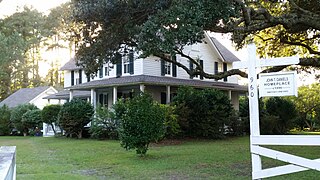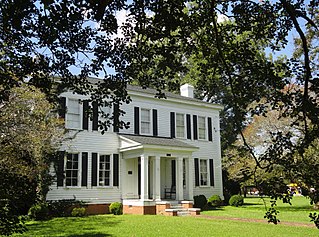
Pinnacle is an unincorporated community and census-designated place in southwestern Stokes County, North Carolina, United States, approximately 5 miles (8.0 km) SSE of the town of Pilot Mountain, between Pilot Mountain State Park and Hanging Rock State Park.

Stagville Plantation is located in Durham County, North Carolina. With buildings constructed from the late 18th century to the mid-19th century, Stagville was part of one of the largest plantation complexes in the American South. The entire complex was owned by the Bennehan, Mantack and Cameron families; it comprised roughly 30,000 acres (120 km2) and was home to almost 900 enslaved African Americans in 1860.

The Thomas Wolfe House, also known as the Thomas Wolfe Memorial, is a state historic site, historic house and museum located at 52 North Market Street in downtown Asheville, North Carolina. The American author Thomas Wolfe (1900–1938) lived in the home during his boyhood. The house was designated a National Historic Landmark in 1971 for its association with Wolfe. It is located in the Downtown Asheville Historic District.
The Frank and Mary Smith House is a historic home located at 2935 John Adams Road in Willow Spring, Wake County, North Carolina, a suburb of Raleigh. The house was built about 1880, and is a two-story, three-bay, single-pile frame I-house with a central hall plan. It is sheathed in weatherboard, has a triple-A-roof, and a 1+1⁄2-story tall shed addition and gabled rear ell.
The Dr. Thomas H. Avera House is a historic house located at 6600 Robertson Pond Road near Wendell, Wake County, North Carolina.
The Heartsfield–Perry Farm is a historic home and farm located at Rolesville, Wake County, North Carolina, a satellite town of the state capital Raleigh. The original one-room house was built in the 1790s, with a Greek Revival style update made about 1840. It is a two-story house with two-story rear ell and one-story rear shed addition. It features a double-tier Greek-Revival-style—porch and low hipped roof. The interior of the house retains some Federal style design elements. Also on the property are the contributing detached kitchen, smokehouse / woodshed, privy, doctor's office, mule barn, pack house, horse barn, feed barn, two tobacco barns, the family cemetery, and the agricultural landscape.

The Carolina Inn is a hotel listed on the National Register of Historic Places on the campus of the University of North Carolina at Chapel Hill in Orange County, North Carolina, which opened in 1924. The Carolina Inn is a member of Historic Hotels of America, the official program of the National Trust for Historic Preservation.
Boger–Hartsell Farm is a historic home and farm located near Concord, Cabarrus County, North Carolina. The farmhouse was built in 1882, and is a one-story, "L" shaped dwelling with Italianate and Greek Revival style design elements. Also on the property are the contributing log barn, a log corncrib, a well house and canopy, a granary, a smokehouse, a hen house, and a washhouse.

John T. Daniels House is a historic home located at Manteo, Dare County, North Carolina. It was built about 1900, and is a two-story frame I-house dwelling with a two-story rear ell and Queen Anne design elements. Also on the property is the former kitchen.

The Belmont City Hall, also known as the Former United States Post Office, is a historic post office building located in Belmont, Gaston County, North Carolina. It was designed by the Treasury Department's Office of the Supervising Architect under the direction of Louis A. Simon, and built in 1939. It is a one-story, five bay Colonial Revival style brick building. At the rear is a stepped-back rectangular secondary block and loading dock. It housed the Belmont post office until 1970, then was converted for use as the Belmont City Hall in 1973.

Scotland Neck Historic District is a national historic district located at Scotland Neck, Halifax County, North Carolina. It encompasses 249 contributing buildings and 1 contributing object in the central business district and surrounding residential sections of the town of Scotland Neck. The district includes notable examples of Greek Revival and Gothic Revival style architecture. Located in the district is the separately listed Hoffman-Bowers-Josey-Riddick House. Other notable buildings include the Fenner-Shields-Lamb House (1827); D. Edmondson Building, E. T. Whitehead drug store ; Scotland Neck Bank (1914); Baptist Church (1917); Trinity Episcopal Church (1924); and town hall and fire station (1939), brick gymnasium and vocational building (1940), and one-story, elongated brick multiple housing unit (1943) built by the Works Progress Administration. The latter building was utilized as a prisoner-of-war camp during World War II.

Amis-Bragg House is a historic home located at Jackson, Northampton County, North Carolina. It was built about 1840, and is a two-story, five bay, single-pile Greek Revival style frame house with a two-story ell and one-story kitchen wing. It has a hipped roof and interior end chimneys. It was the home of Thomas Bragg Jr. (1810-1872), North Carolina governor and member of the United States Senate, purchased the house in 1843 and lived here until 1855.
The former Pembroke High School, also known as the Indian Education Resource Center, is a historic high school building located at Pembroke, Robeson County, North Carolina. It was designed and built by the Public Works Administration in 1939. It is a one-story, brick building consisting of a central entrance pavilion and auditorium, with flanking classroom wings. The building was renovated in late 1992. The building originally housed a high school for Native American students of the Lumbee tribe.

The Grubb–Sigmon–Weisiger House, also known as the Grubb–Grimes–Sigmon House, is a historic home located at Salisbury, Rowan County, North Carolina. It was built in 1911, and is a large two-story, Queen Anne style frame dwelling. It is sheathed in weatherboard and has a wraparound porch. It was rotated 90 degrees to its present orientation in 1927, and the interiors redesigned in the Colonial Revival style in 1939. Other contributing resources are the guest house, playhouse, a garage / stable, truck-garage / workshop, smokehouse, and greenhouse.
Barber Farm, also known as Luckland, is a historic farm complex and national historic district located near Cleveland, Rowan County, North Carolina. The Jacob Barber House was built about 1855, and is a two-story, single-pile, three-bay vernacular Greek Revival style frame dwelling. It has a one-story rear ell and a one-story shed roofed rear porch. Its builder James Graham also built the Robert Knox House and the Hall Family House. Other contributing resources are the cow barn, smokehouse, granary, double crib log barn, well house, log corn crib / barn, carriage house, school, Edward W. Barber House (1870s), Edward W. Barber Well House (1870s), North Carolina Midland Railroad Right-of-Way, and the agricultural landscape.

The Phoenix Historic Property Register is the official listing of the historic and prehistoric properties in the city of Phoenix, the capital and largest city, of the U.S. state of Arizona. The city's register includes most or all places in Phoenix listed on the National Register of Historic Places and many more of local significance.

Dr. Evan Alexander Erwin House is a historic home located at Laurinburg, Scotland County, North Carolina. It was built in 1904, and extensively remodeled in 1939 in the Classical Revival style. It is a two-story, five bay, double pile, frame dwelling, with one-story side-gable flanking side wings. It features a two-story front porch with a flat roof and supported by four square slender wood columns with Tuscan order caps. Also on the property is a contributing two car garage.

Opera House–Starnes Jewelers Building, also known as Starnes Jewelers and Opera House, is a historic commercial building located at Albemarle, Stanly County, North Carolina. It was built in 1907–1908, and is a 2 1/2-story, Colonial Revival style brick building. It has a parapet-front standing-seam metal roof. About 1939, the first floor storefronts were remodeled and fitted with black Carrara glass panel facades and plate glass and chromium display windows and entrances in the Art Moderne style. The building's front was restored in 1990.

Raleigh Water Works and E.B. Bain Water Treatment Plant is a historic water works complex located at Raleigh, North Carolina. The original section was built in 1941, with additions made about 1946–1947, and in the 1960s. The complex includes the shell of the original one-story, brick pump house ; the one-story, brick filter house (1887); and the Art Deco treatment plant (1939-1940) with adjacent settling basins. The main block of the treatment plant is a three-story, three-bay wide mass topped by a hipped, battened metal roof, with flanking stepped back two-story sections. Also on the property are three storage reservoirs for treated water, dating from 1887, 1940 and the 1950s.
Harry Fitzhugh Lee House is a historic home located at Goldsboro, Wayne County, North Carolina. It was built in 1922, and is a two-story, five bay, Colonial Revival style brick dwelling with a gambrel roof and frame shed-roof dormers. A 1+1⁄2-story gambrel roofed addition was built in 1939. It features a covered porch supported by paired Doric order pillars. It was the home of Harry Fitzhugh Lee, a prominent Goldsboro businessman and a great-nephew of General Robert E. Lee.

















